The Complete Carpenter: Prince of Darkness (1988)
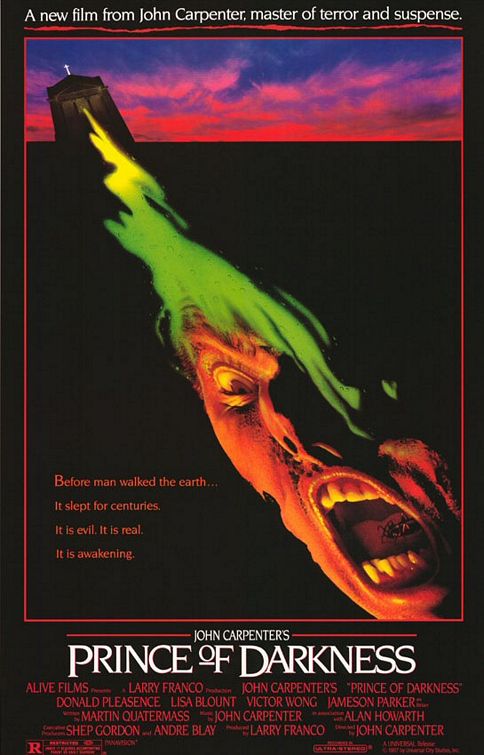 This is where I came in. I’ve reached the point in my John Carpenter career retrospective where I’m writing about a movie to which I’ve already given a full Black Gate article. In fact, it was writing about Prince of Darkness for its 2013 Blu-ray release that planted the idea in my head of surveying the full Carpenter filmography. I’ll make my best effort to offer new insights on Prince of Darkness, but overlap with the previous article is inevitable as I look at the second of John Carpenter’s self-proclaimed “Apocalypse Trilogy,” which starts with The Thing (1982) and ends with In the Mouth of Madness (1994).
This is where I came in. I’ve reached the point in my John Carpenter career retrospective where I’m writing about a movie to which I’ve already given a full Black Gate article. In fact, it was writing about Prince of Darkness for its 2013 Blu-ray release that planted the idea in my head of surveying the full Carpenter filmography. I’ll make my best effort to offer new insights on Prince of Darkness, but overlap with the previous article is inevitable as I look at the second of John Carpenter’s self-proclaimed “Apocalypse Trilogy,” which starts with The Thing (1982) and ends with In the Mouth of Madness (1994).
Prince of Darkness was Carpenter’s return to indie filmmaking after a series of financial disappointments and general aggravation with the big studios. Carpenter made the movie as part of a multi-picture deal with Alive Films that would also include They Live. Universal picked up Prince of Darkness for distribution, and in the fall of 1987 it achieved that rare distinction among Carpenter films: it was a financial success during its initial theatrical run.
The Story
An English priest (Donald Pleasence) discovers a secret that for centuries has been under the protection of an enigmatic monastic sect called the Brotherhood of Sleep: a giant cylinder of swirling green energy held in the underground vault of a church in downtown Los Angeles. The priest calls on his professional acquaintance, physics professor Edward Birack (Victor Wong), to investigate the bizarre phenomenon, which the priest believes is beginning to “awaken.” Birack gathers a team of his graduate students and other researchers for a weekend camp-out in the church to make observations.
To make a long and often baffling story short and perhaps more baffling … The team learns from a medieval volume filled with Latin, Greek, Coptic, and quadratic equations that the cylinder contains Satan, an energy entity that is the son of the Anti-God from an antimatter dimension. The Catholic Church kept the physicality of the evil disguised for two millennia behind religious symbolism. Satan’s essence escapes the containment cylinder and possesses members of the observation team, while a horde of zombified homeless people encircles the church to prevent escape. Nightmare visions possibly sent from the future through tachyon particles portend an apocalyptic nightmare if the Anti-God isn’t prevented from crossing into this reality. Alice Cooper impales a tech nerd on a bicycle and it only gets stranger from there.
The Positives
Prince of Darkness is one weird damn movie, which is why I’m surprised it was successful in 1987. Perhaps the dreamscape visuals of A Nightmare on Elm Street three years earlier prepped audiences to accept surreal, often incomprehensible imagery in their mainstream horror films.
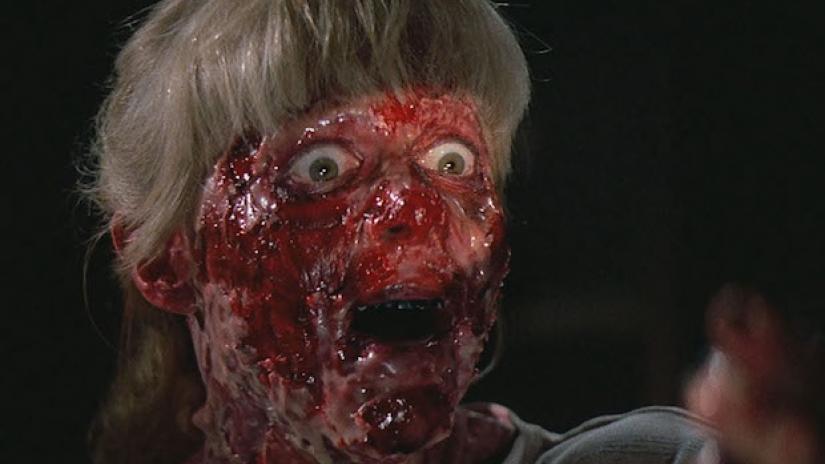 But while weird is always a positive when it comes to horror, mood is what sells the complete package — and Prince of Darkness is like getting crushed under the falling walls of Castle Dracula. It doesn’t make much sense and flies off in eccentric directions, but it’s a triumph of bleak mood and impending doom. Although not at the full masterpiece level of The Thing, it’s compulsively re-watchable and retains its creepy magnetism with each viewing.
But while weird is always a positive when it comes to horror, mood is what sells the complete package — and Prince of Darkness is like getting crushed under the falling walls of Castle Dracula. It doesn’t make much sense and flies off in eccentric directions, but it’s a triumph of bleak mood and impending doom. Although not at the full masterpiece level of The Thing, it’s compulsively re-watchable and retains its creepy magnetism with each viewing.
The central premise is bizarre and beautiful: a merger of quantum mechanics and Catholicism that creates a warped version of Ultimate Evil. It’s half Quatermass and the Pit and half The Omen. What initially sounds like another “monster in the crypt” story lurches into a Secret History of the World once the translator (Ann Yen) reveals her findings from the jumbled medieval volume. Okay, so Jesus was an alien scientist opposing Satan, an energy creature and the offspring of a hostile antimatter entity in a mirror dimension — Birack calls it the “anti-God” — that exists on the subatomic level. Or words to that effect; even Carpenter has admitted he doesn’t fully understand the backstory.
The capper to all this — as if it weren’t already lunatic enough — is that the Catholic Church was created to keep the information a secret. The Church disguised physical evil as metaphysical evil and offered its own “product” as the way of salvation, while meanwhile keeping the real “Satan” in a sealed container under the guardianship of a clandestine order of priests. That’s brilliant: it’s so cracked and conspiratorial that it conjures up vistas far beyond what most religious-based or science-based horror can. It doesn’t hurt to have a voice and face like Donald Pleasence deliver the gloomy pronouncement:
Apparently a decision was made to characterize pure evil as a spiritual force. Evil within the darkness in the hearts of men. That was more convenient. In that way, man remained at the center of things. A stupid lie. We were salesmen, that’s all. We sold our … product to those who didn’t have it. And a new life. Reward ourselves, punish our enemies, so we can live with our truth. Substance. Malevolence. That was the truth. Asleep — until now.
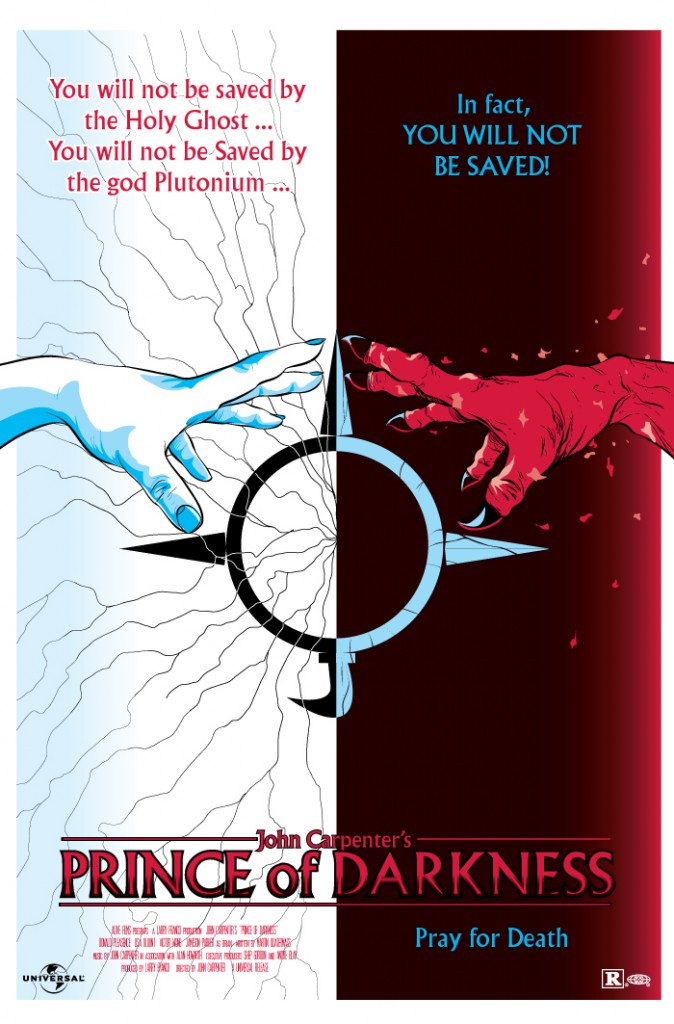 The equal parts combination of religious horror and science horror — a chemical compound that shouldn’t be stable — is the core of what’s fascinating about Prince of Darkness and why it works even when it refuses to explain specifics. Religion puts us at the center of creation. Science gives us the power to understand creation. Then both realities are cruelly ripped away, we are no longer at the center of anything, and the people we expect to protect us are only salesmen, peddling lies to make us feel empowered. But we will not be saved by the God Plutonium. In fact, WE WILL NOT BE SAVED.
The equal parts combination of religious horror and science horror — a chemical compound that shouldn’t be stable — is the core of what’s fascinating about Prince of Darkness and why it works even when it refuses to explain specifics. Religion puts us at the center of creation. Science gives us the power to understand creation. Then both realities are cruelly ripped away, we are no longer at the center of anything, and the people we expect to protect us are only salesmen, peddling lies to make us feel empowered. But we will not be saved by the God Plutonium. In fact, WE WILL NOT BE SAVED.
Ripping apart the surface nature of reality is also a nifty trick that allows the movie frequently to make no goddamn sense. Professor Birack establishes this during the extended opening credits where he states to his students that “logic collapses on the subatomic level into ghosts and shadows.” It also collapses when John Carpenter wants to show you spooky stuff. And there’s plenty of that. The film hustles out a Dario Argento and Mario Bava festival: Gobs of worms sticking to the outside of a church window. Ant swarms on the back of a television. A man’s body coming apart and collapsing into a heap of black beetles. A flood of green liquid pouring down from the ceiling to flood into a woman’s body through her mouth and eyes. A computer screen spewing out chilling words, such as the whole “God Plutonium” business and “I Live!” in repetition like “All Work and No Play …” from The Shining.
The topper of all the phantasmagoria is the future vision haunting the unconscious minds of the people in the church. This is one of the most frightening things Carpenter ever put on screen. Starting with a distorted electronic voice (actually Carpenter’s) proclaiming “This is not a dream …” the jagged video and audio is a nightmare fashioned from simple images and sounds. The vision continues to lengthen throughout the film until appearing in full at the coda, when the dark figure in the church doorway at last emerges. There’s an innate, unsettling quality to the future message that creates the idea of the apocalypse more powerfully than all the visual effects money could buy. Which is good news, since Prince of Darkness only had a $3 million budget.
What I’ve said so far may make it sound as if Prince of Darkness is an impenetrable film. But the construction of the plot works on the basic level of a siege movie, territory Carpenter already knew well from Assault on Precinct 13 and The Thing, as well as a slant on the zombie movie. As the story grows weirder, the tension of the danger inside and outside the church ratchets up, and Carpenter shows he hadn’t lost his touch for suspense setpieces.
The ensemble cast is mostly excellent. The late Lisa Blount creates a tragic character as Catherine Danforth using only insinuations; she shoulders the emotional weight of the film. The performances from Anne Howard as Susan and Jessie Lawrence Ferguson as Calder once they’re possessed are both freaky, but in different ways. Howard is motionless and intense, while Ferguson shakes, laughs, cries, and sings “Amazing Grace” (for some reason). I’ve even started to enjoy the purposely grating character of Walter (Dennis Dun), whose flippant attitude and off-color jokes make for good contrast. “Look, am I crazy or are we stroking ourselves heavily here?” is the exact line you need to remind you, “Wow, this is getting really nuts.” And look: it’s Peter Jason, one of John Carpenter’s favorite actors, making his first of six Carpenter Co. appearances!
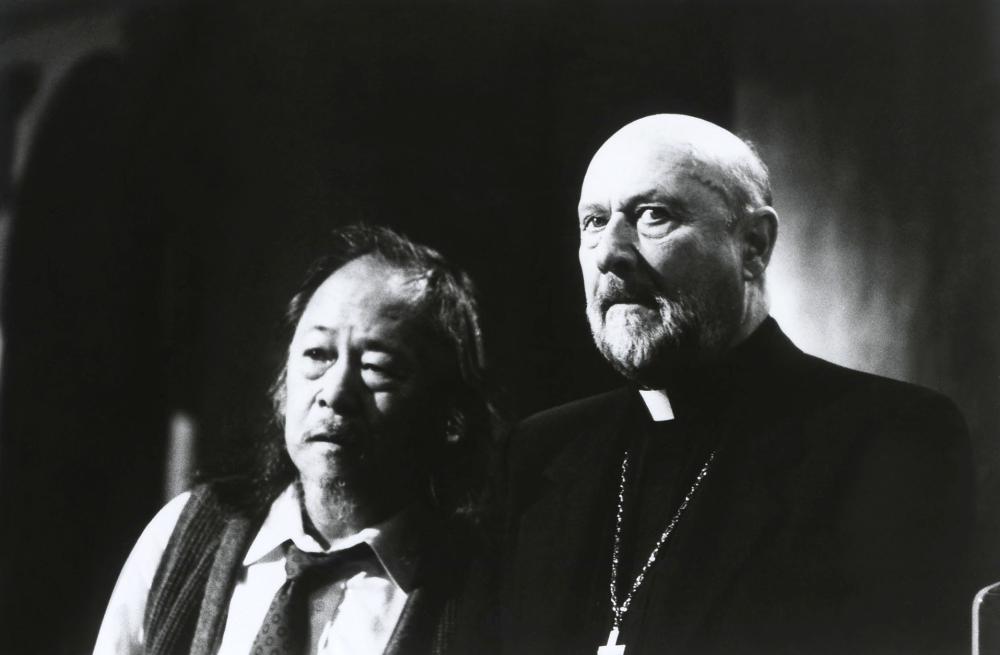 The heart of the cast and the movie are its senior figures: Victor Wong and Donald Pleasence as Scientist and Priest, representing the story’s dual components. Wong is marvelous in his 180-degree shift from the comedy character Egg Shen in Big Trouble in Little China. Wong is intimidating as Professor Birack, a man who scares his own students because of his philosophical and pessimistic approach to a subject they believe should be quantifiable numbers. Donald Pleasence does what he does best: selling the strangest dialogue as if he were playing Iago at Stratford. In any scene between Wong and Pleasance, you know that 1) you won’t really know what they’re talking about, and 2) you’ll be riveted to every word.
The heart of the cast and the movie are its senior figures: Victor Wong and Donald Pleasence as Scientist and Priest, representing the story’s dual components. Wong is marvelous in his 180-degree shift from the comedy character Egg Shen in Big Trouble in Little China. Wong is intimidating as Professor Birack, a man who scares his own students because of his philosophical and pessimistic approach to a subject they believe should be quantifiable numbers. Donald Pleasence does what he does best: selling the strangest dialogue as if he were playing Iago at Stratford. In any scene between Wong and Pleasance, you know that 1) you won’t really know what they’re talking about, and 2) you’ll be riveted to every word.
This is Carpenter’s first film with Gary B. Kibbe as director of photography, who replaced Dean Cundey as Carpenter’s regular cinematographer. Kibbe already had extensive experience as a camera operator and second unit photographer, but Prince of Darkness was his first film as DP — and that’s impressive, because it’s the best-looking movie he shot for Carpenter. The appearance fits with the Carpenter filmography and accentuates the queasy, dark mood. Most awe-inspiring is the look of the scenes in the vast candle-lit vault where the Cylinder of Ultimate Evil is stored. Working with that many candles is no easy feat; just ask Stanley Kubrick. (Gratuitous Barry Lyndon reference, thank you.)
The Carpenter-Alan Howarth score is one of their finest. You won’t find yourself humming along to a catchy synth-rock number, but the soundtrack is a palpable enhancement to the dread. The low bass notes that thump through the music from the moment the Universal logo appears are unsettling reminders of the dark forces at work underneath ordinary life, and the chorale effects add the right dose of religious horror. There are better Carpenter/Howarth scores to listen to, but few that serve their movie as well.
I love the running joke where nobody can remember who Susan is until they’re reminded: “You know — radiologist, glasses.”
The Negatives
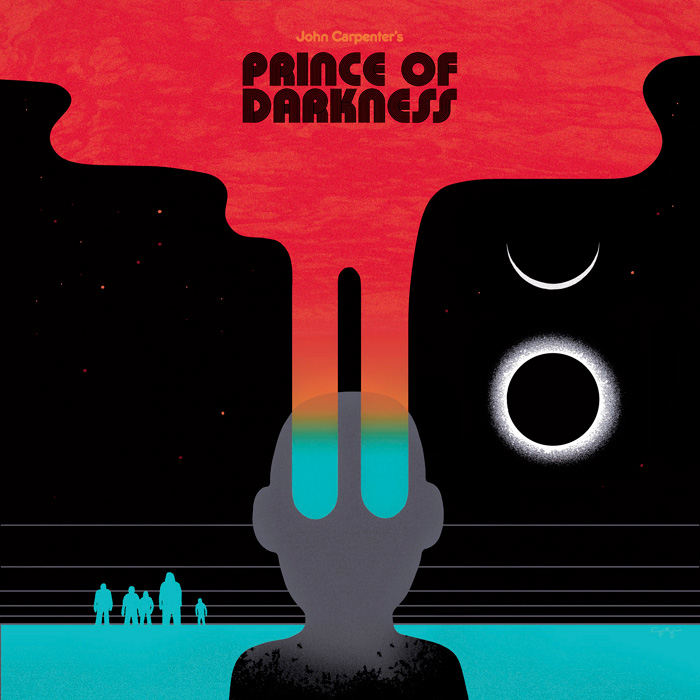 The build of tension hits a snag after the possessed team members make their first major move and the siege element clarifies. The priest hides in the furnace room, Walter gets trapped in a closet in a room with two of the possessed, and the rest of the team hunkers down in an adjacent room where they slowly try to dig through a wall to reach Dennis. The momentum dips here for a ten-minute stretch and it starts to feel as if a pedestrian horror film is emerging. Thankfully, the final rush to get Dennis through the wall slams the pace back up, and the ending is anything but routine horror.
The build of tension hits a snag after the possessed team members make their first major move and the siege element clarifies. The priest hides in the furnace room, Walter gets trapped in a closet in a room with two of the possessed, and the rest of the team hunkers down in an adjacent room where they slowly try to dig through a wall to reach Dennis. The momentum dips here for a ten-minute stretch and it starts to feel as if a pedestrian horror film is emerging. Thankfully, the final rush to get Dennis through the wall slams the pace back up, and the ending is anything but routine horror.
Jameson Parker doesn’t work as Brian Marsh, the ostensible lead. Where Lisa Blount as Catherine projects an unusual pain from an unknown past event, Brian acts like a lech without much deeper thought about what’s going on. This makes the romance one-sided and dampens some of the good work Danforth does. Brian Marsh can talk the science talk, but nothing much seems to be going on behind those eyes. It doesn’t help that Parker looks too ‘80s for a film that achieves a timeless feel once everyone gathers in the church. (Dennis Dunn’s lavender shirt is the other too-eighties-for-the-room element.) And the way Jameson’s mustache parts in the middle when he smiles … now that’s the wrong kind of creepy. Critics in 1987 harped on Prince of Darkness for having uninteresting characters, but I think it was a case of the reviewers disliking Jameson Parker’s performance and applying the feeling to everyone.
Prince of Darkness is capable of getting too obtuse, even within its own parameters. It will bother some viewers more than others. The only place where I find myself taken out of the story because of questions is the sequence of events around Kelly (Susan Blanchard) and her transformation into Satan’s humanoid vessel. In an early scene, she bumps her elbow against a piece of equipment in the vault. This somehow marks her as the conduit for Satan, and the bruise starts to take on the shape of the astrologer’s staff. Why? If this happened because Kelly bumped against the actual cylinder, it would make more sense. Was “Satan” waiting for just anybody to bump into a piece of equipment? Is that its “tell”? The astrologer’s staff feels like a random symbol plucked from a bag of mystical symbols. I can’t put my finger on why this is what itches at the logic centers of my brain and not almost everything else, but it does.
The Pessimistic Carpenter Ending
Catherine Danforth sacrifices herself to prevent the Anti-God from crossing through the mirror into our world. But the world has only gotten a reprieve. Brian receives the future vision again — and the dark figure stepping out of the church is Catherine.
Next: They Live
Ryan Harvey is one of the original bloggers for Black Gate, starting in 2008. He received the Writers of the Future Award for his short story “An Acolyte of Black Spires,” and his stories “The Sorrowless Thief” and “Stand at Dubun-Geb” are available in Black Gate online fiction. A further Ahn-Tarqa adventure, “Farewell to Tyrn”, is available as an e-book. His most recent publication, “The Invasion Will Be Alphabetized,” is now on sale in Stupendous Stories #19. Ryan lives in Costa Mesa, California where he works as a marketing writer. Occasionally, people ask him to talk about Edgar Rice Burroughs or Godzilla in interviews.
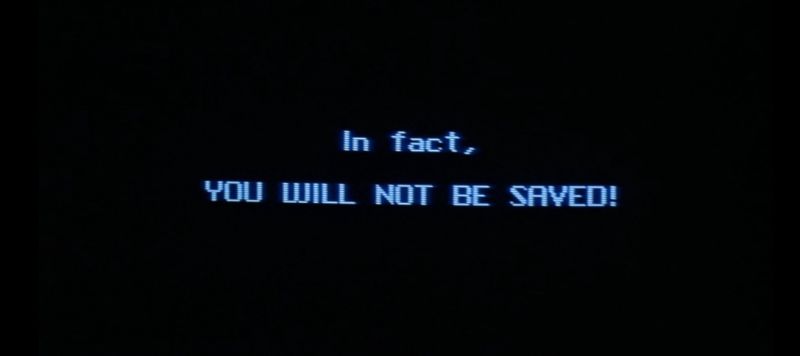
I just rewatched this again recently (after getting the steelbook edition) and for me the moment that always makes the movie is Alice Cooper stabbing a guy to death with a bicycle.
I was under the impression that there’s no particularly good reason for what happens to Kelly. She’s just the sap who happened to be unlucky enough to get chosen. It’s that kind of movie.
We watch this regularly around the Halloween season – how can anyone resist a classic good vs evil storyline – I agree with the assessment that Parker’s character and performance is the wrong match for the lead, he’s great for the expository explanation of the science but droll as a (romantic?!?)lead character – Wong and Pleasance definitely carry the story – In Fergusons case, I felt the contrast of a God fearing man being possessed may make you sing Amazing Grace while wishing death before turning against your inner self and what you believed all your life – great movie nonetheless